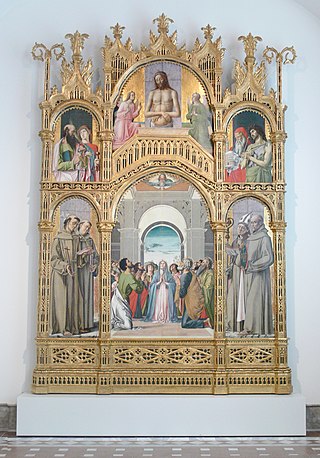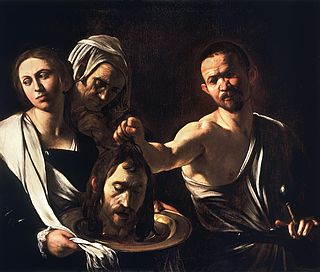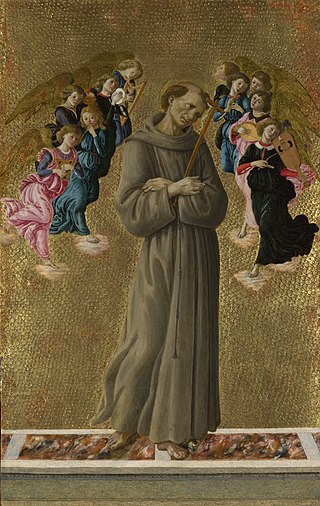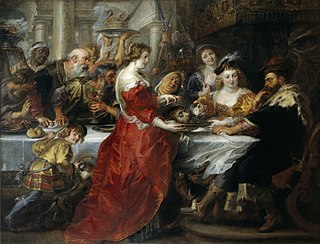
Antonio Allegri da Correggio, usually known as just Correggio, was the foremost painter of the Parma school of the High Italian Renaissance, who was responsible for some of the most vigorous and sensuous works of the sixteenth century. In his use of dynamic composition, illusionistic perspective and dramatic foreshortening, Correggio prefigured the Baroque art of the seventeenth century and the Rococo art of the eighteenth century. He is considered a master of chiaroscuro.

The Basilica dei Santi Giovanni e Paolo, known in Venetian as San Zanipolo, is a church in the Castello sestiere of Venice, Italy.

Alvise or Luigi Vivarini (1442/1453–1503/1505) was an Italian painter, the leading Venetian artist before Giovanni Bellini. Like Bellini, he was part of a dynasty of painters. His father was Antonio Vivarini and his uncle, with whom he may have trained, was Bartolomeo Vivarini. Another uncle, on his mother's side, was the artist known as Giovanni d'Alemagna, who worked with his brother-in-law Antonio. Alvise may have trained Jacopo de' Barbari.

The Gallerie dell'Accademia is a museum gallery of pre-19th-century art in Venice, northern Italy. It is housed in the Scuola della Carità on the south bank of the Grand Canal, within the sestiere of Dorsoduro. It was originally the gallery of the Accademia di Belle Arti di Venezia, the art academy of Venice, from which it became independent in 1879, and for which the Ponte dell'Accademia and the Accademia boat landing station for the vaporetto water bus are named. The two institutions remained in the same building until 2004, when the art school moved to the Ospedale degli Incurabili.

St John's Co-Cathedral is a Roman Catholic co-cathedral in Valletta, Malta, dedicated to Saint John the Baptist. It was built by the Order of St. John between 1573 and 1578, having been commissioned by Grand Master Jean de la Cassière as the Conventual Church of Saint John.

Giovanni di Paolo di Grazia was an Italian painter, working primarily in Siena, becoming a prolific painter and illustrator of manuscripts, including Dante's texts. He was one of the most important painters of the 15th century Sienese School. His early works show the influence of earlier Sienese masters, but his later style was more individual, characterized by cold, harsh colours and elongated forms. His style also took on the influence of International Gothic artists such as Gentile da Fabriano. Many of his works have an unusual dreamlike atmosphere, such as the surrealistic Miracle of St. Nicholas of Tolentino painted about 1455 and now housed in the Philadelphia Museum of Art, while his last works, particularly Last Judgment, Heaven, and Hell from about 1465 and Assumption painted in 1475, both at Pinacoteca Nazionale (Siena), are grotesque treatments of their lofty subjects. Giovanni's reputation declined after his death but was revived in the 20th century.

The beheading of John the Baptist, also known as the decollation of Saint John the Baptist or the beheading of the Forerunner, is a biblical event commemorated as a holy day by various Christian churches. According to the New Testament, Herod Antipas, ruler of Galilee under the Roman Empire, had imprisoned John the Baptist because he had publicly reproved Herod for divorcing his first wife and unlawfully taking his sister-in-law as his second wife Herodias. He then ordered him to be killed by beheading.

Colletorto is a comune (municipality) of approximately 1,786 inhabitants in the Province of Campobasso in the Italian southern region of Molise, located about 45 kilometres (28 mi) from the capital of the region Campobasso and 40 kilometres (25 mi) from Termoli (CB) sea town with port, railway and highway A14.

Paolo di Giovanni Fei was a painter of the Sienese school.

Prato Cathedral, or Cathedral of Saint Stephen, is a Roman Catholic cathedral in Prato, Tuscany, Central Italy, from 1954 the seat of the Bishop of Prato, having been previously, from 1653, a cathedral in the Diocese of Pistoia and Prato. It is dedicated to Saint Stephen, the first Christian martyr.

The Basilica of Saints John and Paul on the Caelian Hill is an ancient basilica church in Rome, located on the Caelian Hill. It was originally built in 398.

The Costabili collection or Costabili Gallery was a large art collection in Ferrara in the 19th century, mainly consisting of Ferrarese art. Works from the collection were purchased by mid and late 19th-century art collectors like Giovanni Morelli, Austen Henry Layard and Charles Eastlake, eventually ending in many of the major collections of art around the world. A significant group of paintings ended up in the National Gallery in London.

The Feast of Herod refers to the episode in the Gospels following the Beheading of St. John the Baptist, when Salome presents his head to her parents. The account in the Book of Mark describes Herod holding a banquet on his birthday for his high officials and military commanders, and leading men of Galilee. At this banquet, Herod's daughter dances before Herod, who is pleased and offers her anything she asks for in return. The girl asks her mother what she should request, and she is told to demand the head of John the Baptist. Reluctantly, Herod orders the beheading of John, and John's head is delivered to her, at her request, "on a platter."(Mark 6:17–29)

Saint John, the Beheaded is a 1940 Italian comedy film directed by Amleto Palermi and Giorgio Bianchi and starring Totò, Titina De Filippo and Silvana Jachino. It was based on a play by Nino Martoglio. The film was made at the Cinecittà Studios in Rome.

San Giovanni Decollato is a Roman Catholic church in Rome, sited on via di San Giovanni Decollato in the Ripa rione, a narrow road named after the church. Its construction took most of the 16th century.
Paolo Caylina the Younger was a 16th-century Italian painter active mainly in Brescia in a Renaissance style.

San Paolo in Campo Marzio is a Roman Catholic church in Verona, region of Veneto, Italy.

Saint John the Baptist Preaching is a 1562 oil-on-canvas painting of John the Baptist by Paolo Veronese, now in the Galleria Borghese in Rome. The painting depicts John the Baptist acting primarily and quite literally as a messenger for the coming of Jesus.

Giovanni Maria Mosca or Giovanni Padovano was an Italian Renaissance sculptor and medallist, active between 1515 and 1573, initially in the Veneto and after 1529 in Poland, where his first name was rendered Jan.
The beheading of John the Baptist is a biblical event commemorated as a holy day by various Christian churches.


















